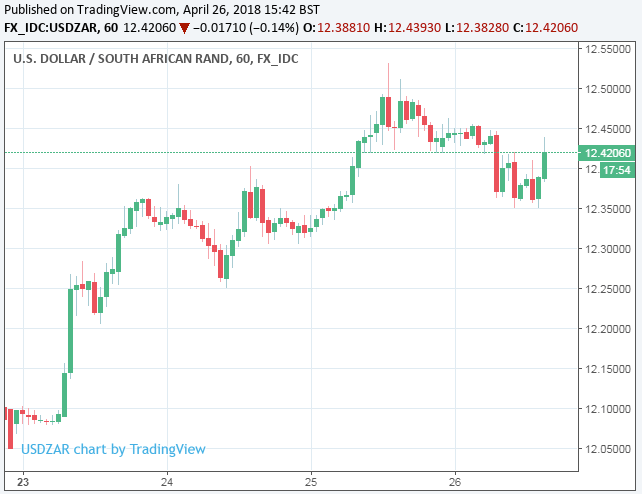South African Rand on Course for Four-year Highs Once US Dollar and Bond Yields Settle Down
- Written by: James Skinner
-
-Rand catches breather as US yield pressure moderates.
-Domestic inflation and interest rate trajectory key to outlook.
-Morgan Stanley forecasts 4 year lows for USD/ZAR and GBP/ZAR.

© Rawpixel.com, Adobe Stock
The Rand was volatile Thursday as traders responded to the latest producer price inflation figures and the ongoing rise of US bond yields, which has put emerging market currencies under pressure this week, but some strategists still say the South African currency will see new highs before the year is out.
American bond yields have been rising sharply in recent days as investors take stock of an increasing supply of US Treasuries due to hit the market and speculation that inflation could also be on the rise.
This saw the 10 year US Treasury yield rise above 3% Wednesday, its highest level since late 2011, and hold comfortably above this threshold for much of the Thursday session.
The US Dollar has drawn support from this movement in the bond market and, given emerging market currencies have a strong negative correlation with the greenback, the Rand had been under pressure for much of the week till Thursday.

Above: 10 Year US Government Bond Yield.
South Africa's currency caught a breather during the overnight session and around noon Thursday, managing to eke out a fractional gain over some of its rivals as the upward pressure on US yields receded a touch - taking them a fraction below 3% late in the noon session. But both yields and the Rand are yet to show signs of a sustained turnaround.

Above: USD/ZAR rate shown at hourly intervals.
The USD/ZAR rate was 0.10% lower at 12.43 during noon session in London while the Pound-to-Rand rate was 0.07% lower at 17.32.

Above: Pound-to-Rand rate shown at hourly intervals.
"Our Fixed Income analysts assume that the appreciation trend of the US yields will not continue further. That means the depreciation pressure on the EM currencies is likely to ease. Short term we even see potential for a recovery once US yields have stabilised," says Elisabeth Andreae, an analyst at Commerzbank.
Advertisement
Get up to 5% more foreign exchange by using a specialist provider to get closer to the real market rate and avoid the gaping spreads charged by your bank when providing currency. Learn more here.
Reserve Bank and Inflation in Focus
This would ease one major source of pressure on the Rand but do little to address the trajectory of South African inflation and monetary policy, which may also have been a factor behind wobbly Rand price action during the Thursday session.
South African producer price inflation fell sharply, coming in much lower than was expected for the month of March. This feeds into fears over the South African Reserve Bank and its interest rate policy. The SARB already cut interest rates once, back in March, and although it suggested that was a "one and done" affair it wouldn't take much to stoke concerns of more interest rate cuts to come.
This would be bad for the Rand in an environment where global interest rates, particularly those in the US, are rising because it would reduce the relative attractiveness of South African assets to investors.
"The better-than-expected inflation outcomes of recent months strengthen the case for accommodative monetary policy. The Reserve Bank’s latest consumer inflation forecast reflects a mild upward trend over the next three years. However, considerable upside risks remain," says Busisiwe Radebe, an economist at Nedbank. "We think the MPC will probably leave policy rates unchanged for the rest of the year before embarking on a mild tightening cycle from around September 2019."
As it happens, Radebe is not alone as most analysts appear to see this inflation weakness as only temporary. In addition, few analysts see any scope for more interest rate cuts in the near future, with most either predicting the SARB will sit on its hands or that it will actually raise rates.
"With inflation at above SARB's comfort zone next year we think policy rate is about right. SARB has consistently been reiterating that it is not in a rate cutting cycle and would like to see inflation expectations edge lower. These factors should limit scope for further rate cuts especially while global volatility also persists," says Ferhan Salman, an emerging market economist at Bank of America Merrill Lynch.
USD/ZAR and GBP/ZAR Set for 4 Year Lows?
The Bank of America team say much of the recent weakness in South African inflation measures are the result of earlier strength in the Rand and favourable food price developments but they warn the price of oil, which has risen 11% in the year to date, will push inflation higher later this year and next. They are not alone in this view.
"Despite the recent downside CPI surprise, our economist believes the SARB’s easing cycle is over, which will be good for short-term investors seeking carry on ZAR FX but also real money investors exposed to the bond market. We expect bond and equity inflows to keep ZAR supported," says Ellie Heatherill, an FX strategist at Morgan Stanley.
Heatherill and the Morgan Stanley FX team forecast a continued but steady appreciation for the South African Rand throughout this year and next.
They predict the USD/ZAR rate will reach a four year low of 10.80 before the end of 2018 and 10.50 by the time 2019 is out. The Pound-to-Rand exchange rate is seen dropping sharply to a five year low of 14.91 before the curtain closes on 2018, where it is projected to remain throughout much of 2019.
"Further policy rate cuts likely to be limited (markets price in almost a full 25bp cut) and lack the potential to push USDZAR away from its range," chimes Shahab Jalinoos, an FX strategist at Credit Suisse. "We expect USDZAR to break lower its post-ANC’s lows of 11.51 and continue to recommend selling USDZAR on spikes."
Advertisement
Get up to 5% more foreign exchange by using a specialist provider to get closer to the real market rate and avoid the gaping spreads charged by your bank when providing currency. Learn more here.





